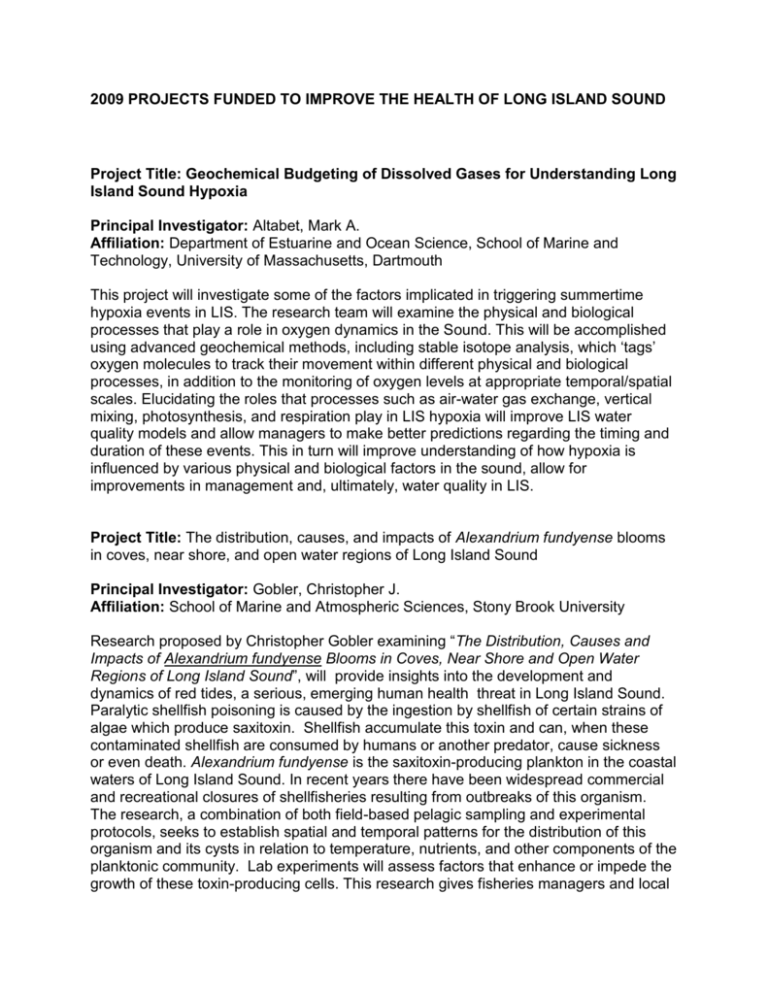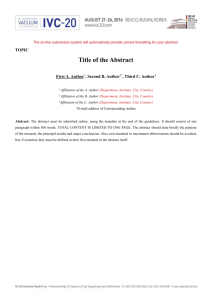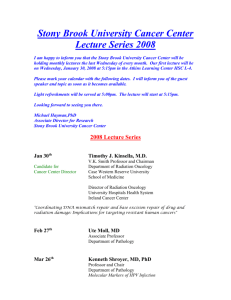Project Title: Geochemical Budgeting of Dissolved Gases for
advertisement

2009 PROJECTS FUNDED TO IMPROVE THE HEALTH OF LONG ISLAND SOUND Project Title: Geochemical Budgeting of Dissolved Gases for Understanding Long Island Sound Hypoxia Principal Investigator: Altabet, Mark A. Affiliation: Department of Estuarine and Ocean Science, School of Marine and Technology, University of Massachusetts, Dartmouth This project will investigate some of the factors implicated in triggering summertime hypoxia events in LIS. The research team will examine the physical and biological processes that play a role in oxygen dynamics in the Sound. This will be accomplished using advanced geochemical methods, including stable isotope analysis, which ‘tags’ oxygen molecules to track their movement within different physical and biological processes, in addition to the monitoring of oxygen levels at appropriate temporal/spatial scales. Elucidating the roles that processes such as air-water gas exchange, vertical mixing, photosynthesis, and respiration play in LIS hypoxia will improve LIS water quality models and allow managers to make better predictions regarding the timing and duration of these events. This in turn will improve understanding of how hypoxia is influenced by various physical and biological factors in the sound, allow for improvements in management and, ultimately, water quality in LIS. Project Title: The distribution, causes, and impacts of Alexandrium fundyense blooms in coves, near shore, and open water regions of Long Island Sound Principal Investigator: Gobler, Christopher J. Affiliation: School of Marine and Atmospheric Sciences, Stony Brook University Research proposed by Christopher Gobler examining “The Distribution, Causes and Impacts of Alexandrium fundyense Blooms in Coves, Near Shore and Open Water Regions of Long Island Sound”, will provide insights into the development and dynamics of red tides, a serious, emerging human health threat in Long Island Sound. Paralytic shellfish poisoning is caused by the ingestion by shellfish of certain strains of algae which produce saxitoxin. Shellfish accumulate this toxin and can, when these contaminated shellfish are consumed by humans or another predator, cause sickness or even death. Alexandrium fundyense is the saxitoxin-producing plankton in the coastal waters of Long Island Sound. In recent years there have been widespread commercial and recreational closures of shellfisheries resulting from outbreaks of this organism. The research, a combination of both field-based pelagic sampling and experimental protocols, seeks to establish spatial and temporal patterns for the distribution of this organism and its cysts in relation to temperature, nutrients, and other components of the planktonic community. Lab experiments will assess factors that enhance or impede the growth of these toxin-producing cells. This research gives fisheries managers and local health departments the essential information they need to protect human health and sustain healthy ecosystems and local economies. Project Title: Impacts of climate change on the export of the spring bloom in Long Island Sound Principal Investigator: Lonsdale, Darcy J. Affiliation: School of Marine and Atmospheric Sciences, Stony Brook University Co-Principal Investigator: Gobler, Christopher J. Affiliation: School of Marine and Atmospheric Sciences, Stony Brook University Darcy Lonsdale and Christopher Gobler’s research, “Impacts of Climate Change on the Export of the Spring Bloom in Long Island Sound” examines the relationship between winter temperature and the abundance and composition of phytoplankton in the spring and explores potential impacts of changing winter water temperatures on local food webs. Their research, a combination of field collection and experimental lab work, will provide important insights into the potential impacts of climate change on marine systems in Long Island Sound. Water temperatures in Long Island Sound are increasing and warmer winter waters are associated with more zooplankton grazing. Grazing lowers phytoplankton growth, thus allowing the levels of nutrients, such as nitrogen, to remain high. These dynamic changes in production caused by a changing climate have serious implications for the development of hypoxic events, feeding relationships, and ultimately fisheries production in Long Island Sound. This exciting research constitutes a critical step in elucidating these relationships. Project Title: Interaction of Biological and Physical factors controlling bottom dissolved Oxygen Principal Investigator: Lwiza, Kamazima, M. Affiliation: School of Marine and Atmospheric Sciences, Stony Brook University Co-Principal Investigator: Taylor, Gordon, T Affiliation: School of Marine and Atmospheric Sciences, Stony Brook University Assessing the “Interaction of Biological and Physical Factors Controlling Bottom Oxygen in Long Island Sound” is the focus of research to be initiated by Kamazima Lwiza and Gordon Taylor. The investigators plan to identify drivers of hypoxia and elucidate relationships among them. Chemical and biological data will be collected from preexisting sampling stations, including samplers placed on the Bridgeport to Port Jefferson ferry boats and buoys outfitted with sampling devices. Additional data will be collected during sampling cruises. These diverse sampling regimes will produce a set of spatially and temporally scaled data, including both fine-grained hourly data and longer time-series encompassing years. On the basis of these observations, a biogeochemical model will be developed to provide managers with a better understanding of the triggers of hypoxia and therefore a better means of predicting hypoxic events in Long Island Sound. Project Title: Summer synoptic weather variability as the control of the seasonal evolution of hypoxia. Principal Investigator: Wilson, Robert, E. Affiliation: School of Marine and Atmospheric Sciences, Stony Brook University Co-Principal Investigator: Colle, Brian, A. Affiliation: School of Marine and Atmospheric Sciences, Stony Brook University Co-Principal Investigator: Codiga, Daniel, L Affiliation: GSO, University of Rhode Island This project plans to study the effect of weather patterns on LIS hypoxia, specifically to assess the effects of changes in frequency and track position of extratropical summertime storms on both inter-annual and long term variations in the severity of hypoxia. Previous observations by the research team indicate that the common weather pattern seen over LIS is the passage of a low-pressure center to the north of Long Island Sound with an associated cold front passage. They hypothesize that these systems with their associated heat and momentum fluxes are a primary agent responsible for mixing bottom waters and determining the oxygen levels in these waters. Analyzing existing data collections, the investigators will test this hypothesis and provide more detailed information about vertical mixing and bottom oxygen levels. This information should be useful for the development of management plans to reduce low oxygen events.







